Analysis of Strategies for Managing Corporate Sustainability
VerifiedAdded on 2023/03/20
|18
|3990
|68
Report
AI Summary
This report delves into the multifaceted realm of corporate sustainability, examining the strategies employed by businesses to address environmental, social, and economic dimensions. The research begins by establishing the importance of corporate sustainability, its evolution, and the underlying principles that guide it, including morality, norms, and ethics. The methodology section outlines the use of qualitative research, specifically content analysis, to analyze academic sources and assess different strategies. The findings and discussions chapter explores the three pillars of corporate sustainability: economic, environmental, and social, along with the reasons for its increasing adoption by companies. Furthermore, the report analyzes various strategies, such as managing knowledge through sustainable information and communication technology, and forming partnerships, providing a comprehensive understanding of how companies can effectively integrate sustainability into their operations. The report highlights the benefits of corporate sustainability, including improved stakeholder relations, cost reduction, and enhanced moral and societal obligations, offering valuable insights for businesses striving to achieve long-term value and responsible practices.
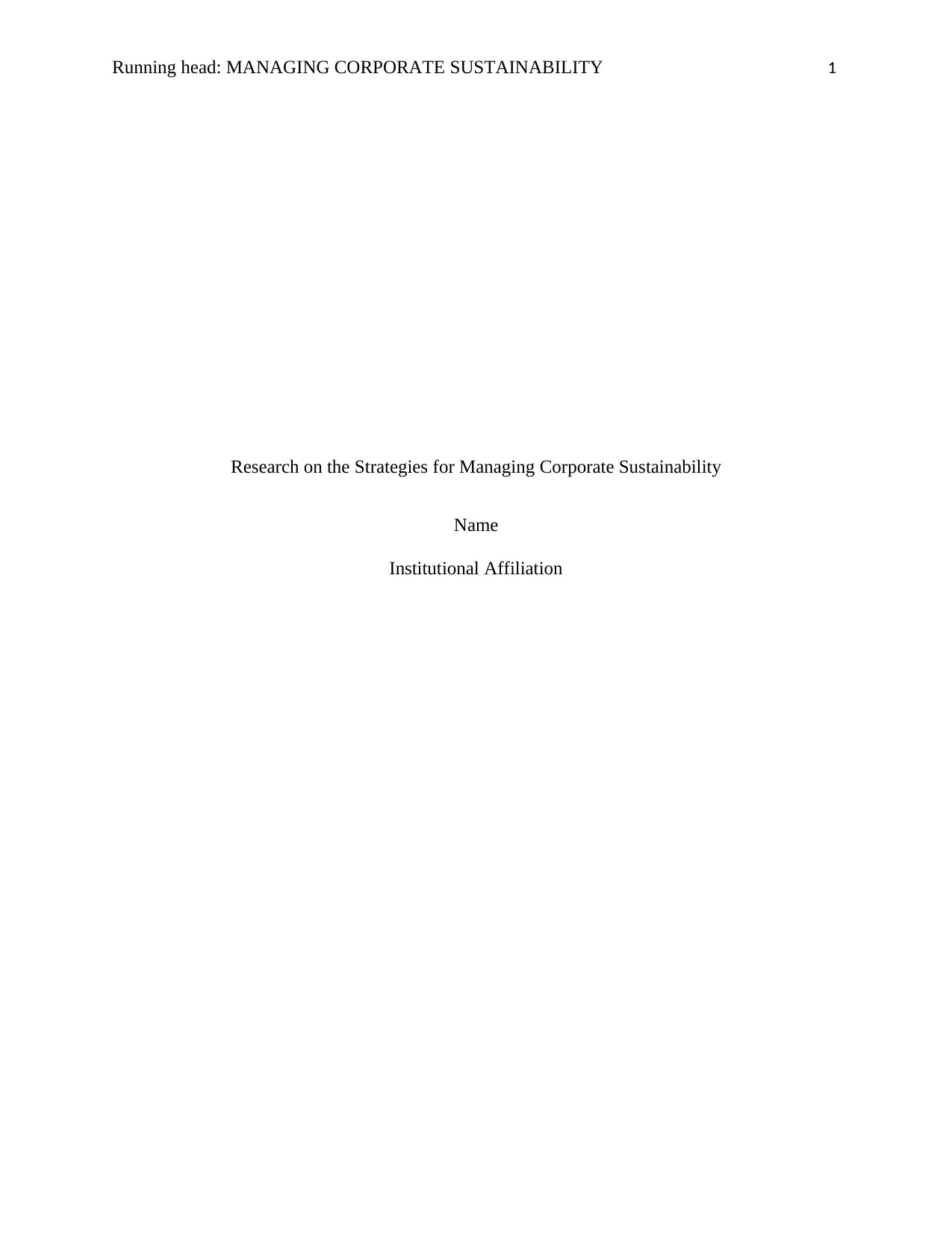
Running head: MANAGING CORPORATE SUSTAINABILITY 1
Research on the Strategies for Managing Corporate Sustainability
Name
Institutional Affiliation
Research on the Strategies for Managing Corporate Sustainability
Name
Institutional Affiliation
Paraphrase This Document
Need a fresh take? Get an instant paraphrase of this document with our AI Paraphraser
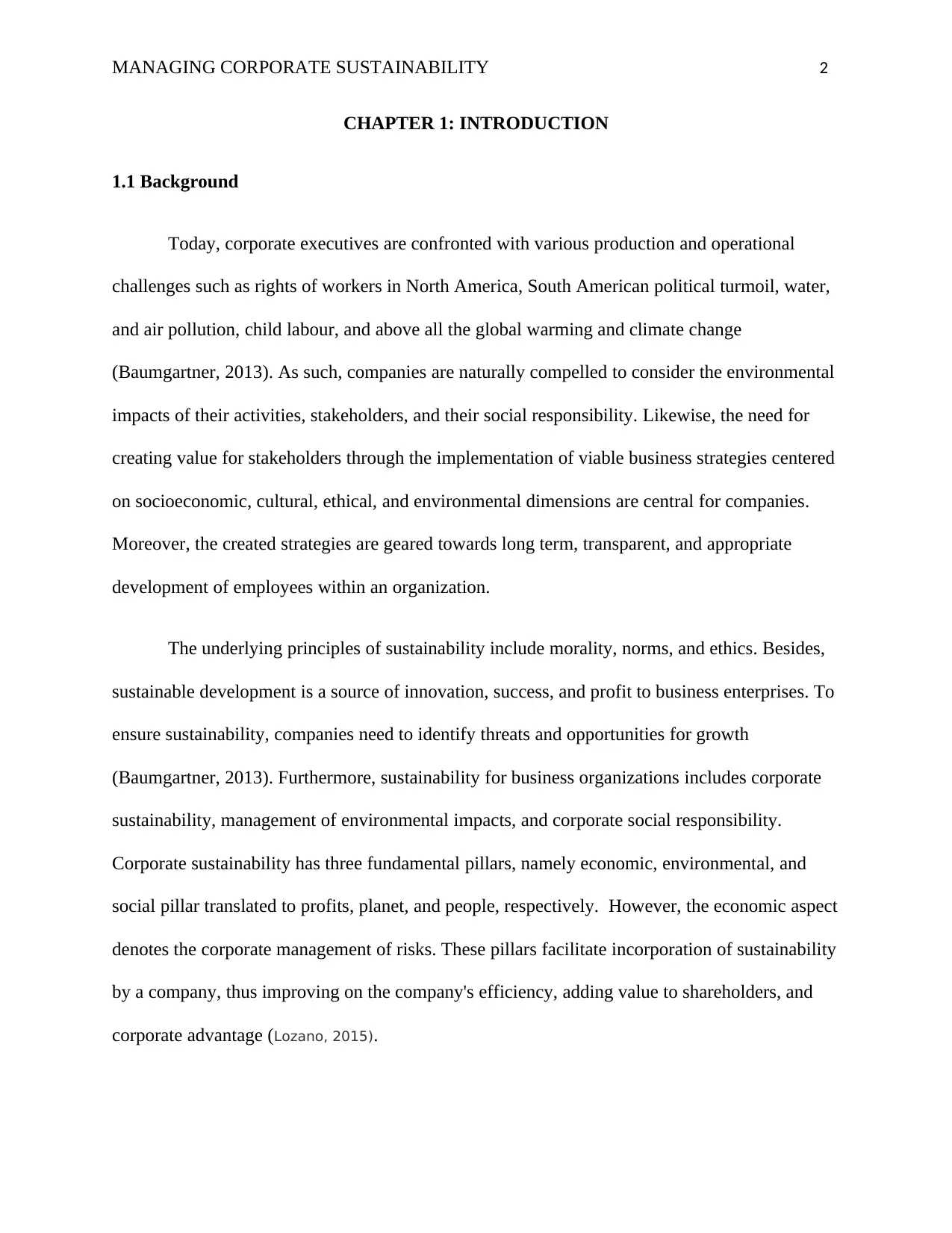
MANAGING CORPORATE SUSTAINABILITY 2
CHAPTER 1: INTRODUCTION
1.1 Background
Today, corporate executives are confronted with various production and operational
challenges such as rights of workers in North America, South American political turmoil, water,
and air pollution, child labour, and above all the global warming and climate change
(Baumgartner, 2013). As such, companies are naturally compelled to consider the environmental
impacts of their activities, stakeholders, and their social responsibility. Likewise, the need for
creating value for stakeholders through the implementation of viable business strategies centered
on socioeconomic, cultural, ethical, and environmental dimensions are central for companies.
Moreover, the created strategies are geared towards long term, transparent, and appropriate
development of employees within an organization.
The underlying principles of sustainability include morality, norms, and ethics. Besides,
sustainable development is a source of innovation, success, and profit to business enterprises. To
ensure sustainability, companies need to identify threats and opportunities for growth
(Baumgartner, 2013). Furthermore, sustainability for business organizations includes corporate
sustainability, management of environmental impacts, and corporate social responsibility.
Corporate sustainability has three fundamental pillars, namely economic, environmental, and
social pillar translated to profits, planet, and people, respectively. However, the economic aspect
denotes the corporate management of risks. These pillars facilitate incorporation of sustainability
by a company, thus improving on the company's efficiency, adding value to shareholders, and
corporate advantage (Lozano, 2015).
CHAPTER 1: INTRODUCTION
1.1 Background
Today, corporate executives are confronted with various production and operational
challenges such as rights of workers in North America, South American political turmoil, water,
and air pollution, child labour, and above all the global warming and climate change
(Baumgartner, 2013). As such, companies are naturally compelled to consider the environmental
impacts of their activities, stakeholders, and their social responsibility. Likewise, the need for
creating value for stakeholders through the implementation of viable business strategies centered
on socioeconomic, cultural, ethical, and environmental dimensions are central for companies.
Moreover, the created strategies are geared towards long term, transparent, and appropriate
development of employees within an organization.
The underlying principles of sustainability include morality, norms, and ethics. Besides,
sustainable development is a source of innovation, success, and profit to business enterprises. To
ensure sustainability, companies need to identify threats and opportunities for growth
(Baumgartner, 2013). Furthermore, sustainability for business organizations includes corporate
sustainability, management of environmental impacts, and corporate social responsibility.
Corporate sustainability has three fundamental pillars, namely economic, environmental, and
social pillar translated to profits, planet, and people, respectively. However, the economic aspect
denotes the corporate management of risks. These pillars facilitate incorporation of sustainability
by a company, thus improving on the company's efficiency, adding value to shareholders, and
corporate advantage (Lozano, 2015).

MANAGING CORPORATE SUSTAINABILITY 3
However, the development and implementation of a proactive sustainability strategy is an
uphill task for senior executives. Successful strategies usually have the backing of the chief
executive officers since they act as the drivers in implementing a strategy. As a consequence, top
management of a company is usually challenged on the best technique for improving holistic
productivity of the company while at the same time upholding the fundamental elements of a
company’s sustainable performance such as financial, environmental, and social performance
(Epstein & Buhovac, 2017).
1.2 Aim of the research
The main aim of the research was to explore the management of corporate sustainability
as well as analyzing the strategies for the management of corporate sustainability. Besides, other
aims of the study are listed below:
To define why managing corporate sustainability is essential.
To replicate reports from literary critics on the significance of corporate sustainability.
To examine how corporate sustainability has evolved.
CHAPTER 2: METHODOLOGY
2.2. Research Methodology-Qualitative Research
The research used qualitative research. The research used observation, library research
and knowledge-based judgment for analysis of the appropriate academic sources for the
research.
2.2 Data Analysis
Data analysis is the logical techniques or systematic application of statists in describing
However, the development and implementation of a proactive sustainability strategy is an
uphill task for senior executives. Successful strategies usually have the backing of the chief
executive officers since they act as the drivers in implementing a strategy. As a consequence, top
management of a company is usually challenged on the best technique for improving holistic
productivity of the company while at the same time upholding the fundamental elements of a
company’s sustainable performance such as financial, environmental, and social performance
(Epstein & Buhovac, 2017).
1.2 Aim of the research
The main aim of the research was to explore the management of corporate sustainability
as well as analyzing the strategies for the management of corporate sustainability. Besides, other
aims of the study are listed below:
To define why managing corporate sustainability is essential.
To replicate reports from literary critics on the significance of corporate sustainability.
To examine how corporate sustainability has evolved.
CHAPTER 2: METHODOLOGY
2.2. Research Methodology-Qualitative Research
The research used qualitative research. The research used observation, library research
and knowledge-based judgment for analysis of the appropriate academic sources for the
research.
2.2 Data Analysis
Data analysis is the logical techniques or systematic application of statists in describing
⊘ This is a preview!⊘
Do you want full access?
Subscribe today to unlock all pages.

Trusted by 1+ million students worldwide
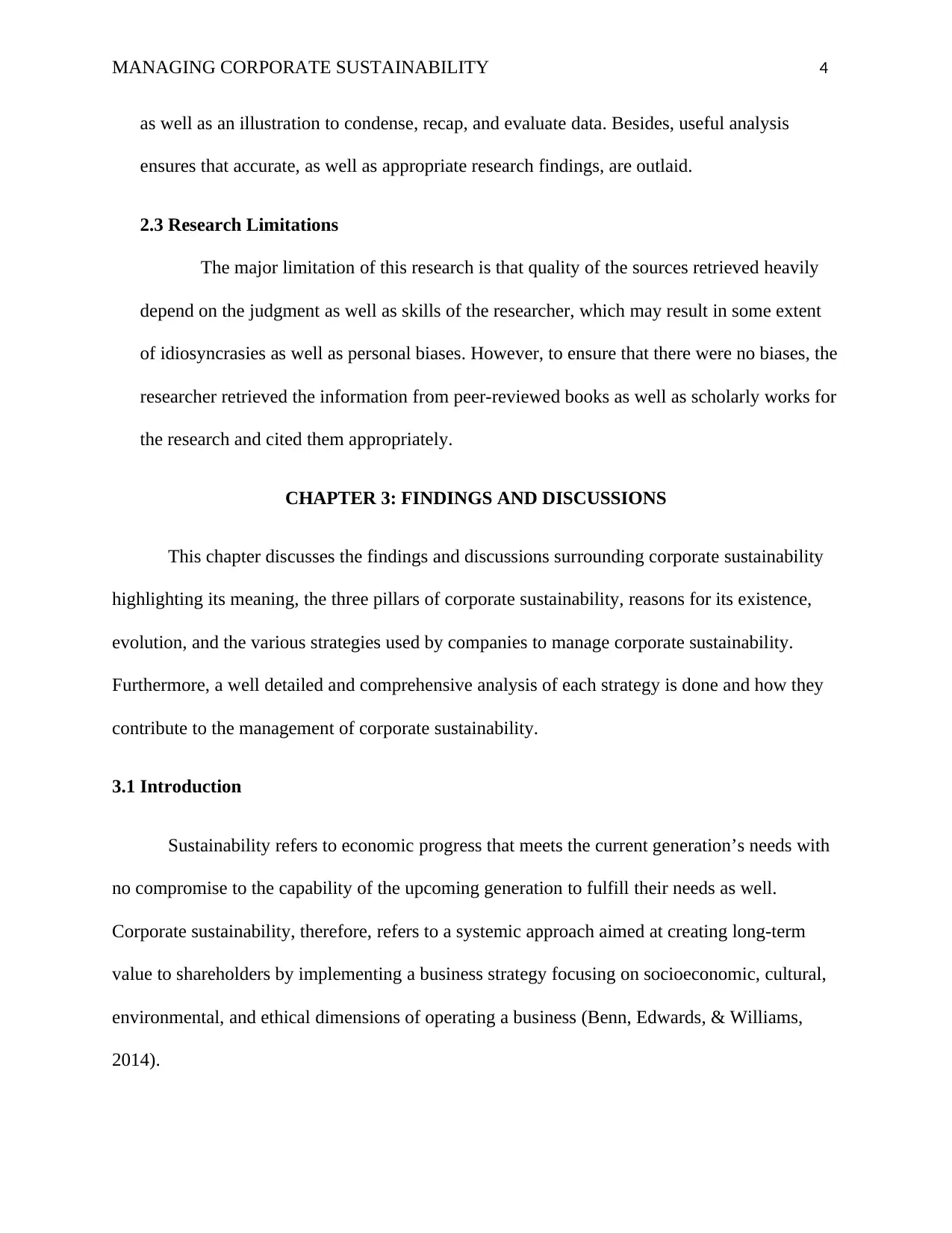
MANAGING CORPORATE SUSTAINABILITY 4
as well as an illustration to condense, recap, and evaluate data. Besides, useful analysis
ensures that accurate, as well as appropriate research findings, are outlaid.
2.3 Research Limitations
The major limitation of this research is that quality of the sources retrieved heavily
depend on the judgment as well as skills of the researcher, which may result in some extent
of idiosyncrasies as well as personal biases. However, to ensure that there were no biases, the
researcher retrieved the information from peer-reviewed books as well as scholarly works for
the research and cited them appropriately.
CHAPTER 3: FINDINGS AND DISCUSSIONS
This chapter discusses the findings and discussions surrounding corporate sustainability
highlighting its meaning, the three pillars of corporate sustainability, reasons for its existence,
evolution, and the various strategies used by companies to manage corporate sustainability.
Furthermore, a well detailed and comprehensive analysis of each strategy is done and how they
contribute to the management of corporate sustainability.
3.1 Introduction
Sustainability refers to economic progress that meets the current generation’s needs with
no compromise to the capability of the upcoming generation to fulfill their needs as well.
Corporate sustainability, therefore, refers to a systemic approach aimed at creating long-term
value to shareholders by implementing a business strategy focusing on socioeconomic, cultural,
environmental, and ethical dimensions of operating a business (Benn, Edwards, & Williams,
2014).
as well as an illustration to condense, recap, and evaluate data. Besides, useful analysis
ensures that accurate, as well as appropriate research findings, are outlaid.
2.3 Research Limitations
The major limitation of this research is that quality of the sources retrieved heavily
depend on the judgment as well as skills of the researcher, which may result in some extent
of idiosyncrasies as well as personal biases. However, to ensure that there were no biases, the
researcher retrieved the information from peer-reviewed books as well as scholarly works for
the research and cited them appropriately.
CHAPTER 3: FINDINGS AND DISCUSSIONS
This chapter discusses the findings and discussions surrounding corporate sustainability
highlighting its meaning, the three pillars of corporate sustainability, reasons for its existence,
evolution, and the various strategies used by companies to manage corporate sustainability.
Furthermore, a well detailed and comprehensive analysis of each strategy is done and how they
contribute to the management of corporate sustainability.
3.1 Introduction
Sustainability refers to economic progress that meets the current generation’s needs with
no compromise to the capability of the upcoming generation to fulfill their needs as well.
Corporate sustainability, therefore, refers to a systemic approach aimed at creating long-term
value to shareholders by implementing a business strategy focusing on socioeconomic, cultural,
environmental, and ethical dimensions of operating a business (Benn, Edwards, & Williams,
2014).
Paraphrase This Document
Need a fresh take? Get an instant paraphrase of this document with our AI Paraphraser
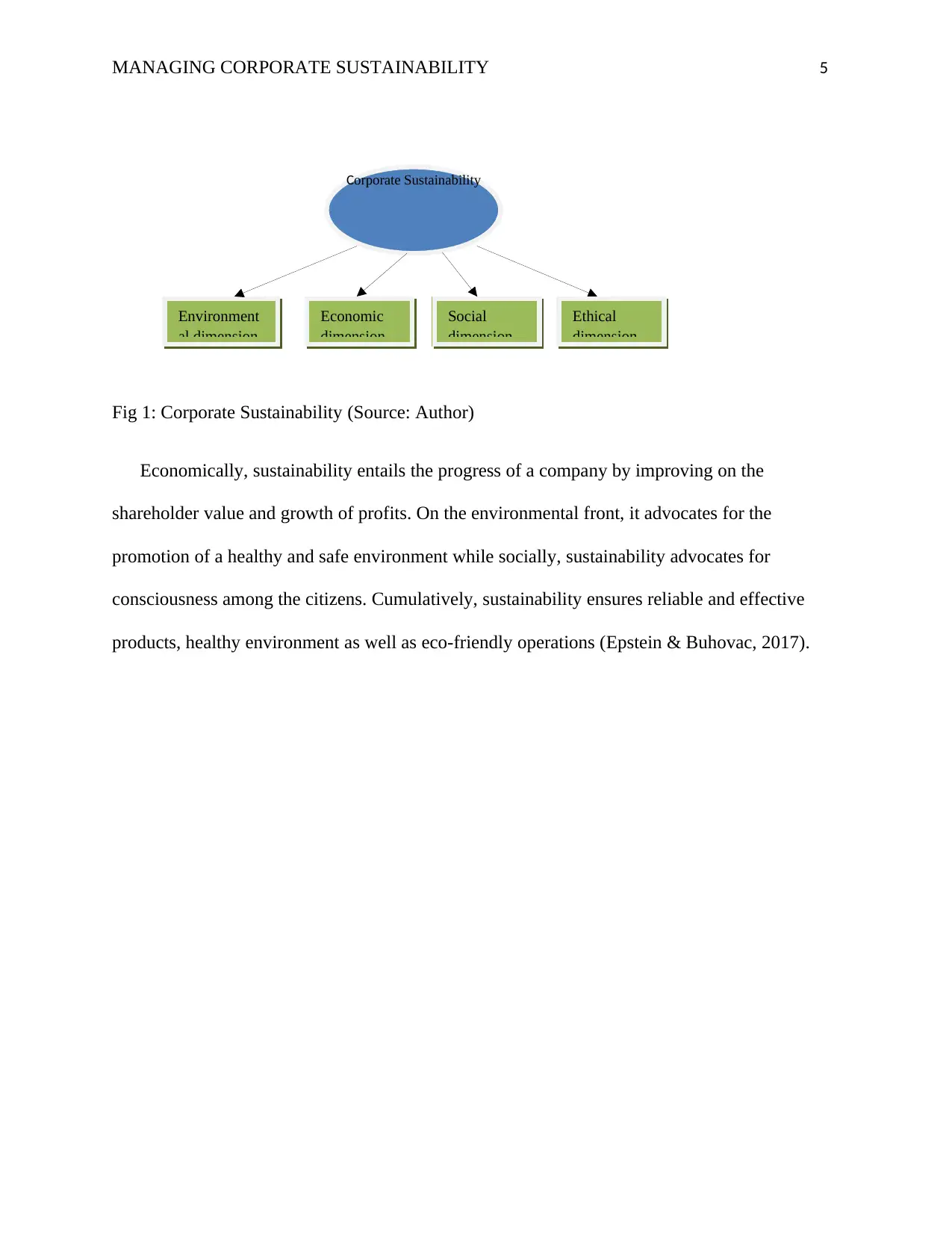
MANAGING CORPORATE SUSTAINABILITY 5
Fig 1: Corporate Sustainability (Source: Author)
Economically, sustainability entails the progress of a company by improving on the
shareholder value and growth of profits. On the environmental front, it advocates for the
promotion of a healthy and safe environment while socially, sustainability advocates for
consciousness among the citizens. Cumulatively, sustainability ensures reliable and effective
products, healthy environment as well as eco-friendly operations (Epstein & Buhovac, 2017).
Corporate Sustainability
Environment
al dimension
Economic
dimension
Social
dimension
Ethical
dimension
Fig 1: Corporate Sustainability (Source: Author)
Economically, sustainability entails the progress of a company by improving on the
shareholder value and growth of profits. On the environmental front, it advocates for the
promotion of a healthy and safe environment while socially, sustainability advocates for
consciousness among the citizens. Cumulatively, sustainability ensures reliable and effective
products, healthy environment as well as eco-friendly operations (Epstein & Buhovac, 2017).
Corporate Sustainability
Environment
al dimension
Economic
dimension
Social
dimension
Ethical
dimension

MANAGING CORPORATE SUSTAINABILITY 6
Figure 2: Pillars of Corporate Sustainability (Source: Lozano, 2015)
3.2 Origin of Corporate Sustainability
Corporate sustainability is a substitute for the traditional model of maximization of profit and
growth. Mel (2016) notes that although corporate sustainability recognizes the importance of
profitability and organizational growth, it also stresses on the pursuit of social goals such as
economic development, equity, social justice, protection of the environment, and sustainable
development. According to Mel (2016), the concept of corporate sustainability is derived from
four concepts, namely corporate accountability theory, stakeholder theory, corporate social
responsibility (CSR), and sustainable development.
Figure 2: Pillars of Corporate Sustainability (Source: Lozano, 2015)
3.2 Origin of Corporate Sustainability
Corporate sustainability is a substitute for the traditional model of maximization of profit and
growth. Mel (2016) notes that although corporate sustainability recognizes the importance of
profitability and organizational growth, it also stresses on the pursuit of social goals such as
economic development, equity, social justice, protection of the environment, and sustainable
development. According to Mel (2016), the concept of corporate sustainability is derived from
four concepts, namely corporate accountability theory, stakeholder theory, corporate social
responsibility (CSR), and sustainable development.
⊘ This is a preview!⊘
Do you want full access?
Subscribe today to unlock all pages.

Trusted by 1+ million students worldwide

MANAGING CORPORATE SUSTAINABILITY 7
Sustainable development strikes a balance between social equity, environmental protection,
and economic growth. As a consequence, sustainable development outlines that development in
which resource exploitation, investment's direction, technological orientation, and institutional
change are in harmony with the potential of people to meet their needs both at present and in the
future. Furthermore, corporate social responsibility (CSR) advocates for a fair society where the
needs of all people in the globe are taken into consideration concerning power and wealth. It
incorporates social contract, social justice, rights, and deontological theories (Mel, 2016).
Moreover, stakeholder theory posits that there is a positive correlation between the strength
of the relationships with external parties and the corporate objectives. Stakeholders of a company
include shareholders, employees, investors, suppliers, and customers. Healthy relationships are
rooted in cooperation, respect, and trust. To note, stakeholder theory is a concept of strategic
management contrary to CSR, which is predominantly philosophical (Mel, 2016). The main goal
of stakeholder theory, therefore, is to facilitate stakeholders to bond stronger relationships with
outside groups. Lastly, corporate accountability theory demands managers to report, justify, and
explain their actions specifically to shareholders. As such, corporate accountability brings about
trust, thus acting as an incentive to investors (Mel, 2016). A combination of all four aspects
constitutes corporate sustainability.
Sustainable development strikes a balance between social equity, environmental protection,
and economic growth. As a consequence, sustainable development outlines that development in
which resource exploitation, investment's direction, technological orientation, and institutional
change are in harmony with the potential of people to meet their needs both at present and in the
future. Furthermore, corporate social responsibility (CSR) advocates for a fair society where the
needs of all people in the globe are taken into consideration concerning power and wealth. It
incorporates social contract, social justice, rights, and deontological theories (Mel, 2016).
Moreover, stakeholder theory posits that there is a positive correlation between the strength
of the relationships with external parties and the corporate objectives. Stakeholders of a company
include shareholders, employees, investors, suppliers, and customers. Healthy relationships are
rooted in cooperation, respect, and trust. To note, stakeholder theory is a concept of strategic
management contrary to CSR, which is predominantly philosophical (Mel, 2016). The main goal
of stakeholder theory, therefore, is to facilitate stakeholders to bond stronger relationships with
outside groups. Lastly, corporate accountability theory demands managers to report, justify, and
explain their actions specifically to shareholders. As such, corporate accountability brings about
trust, thus acting as an incentive to investors (Mel, 2016). A combination of all four aspects
constitutes corporate sustainability.
Paraphrase This Document
Need a fresh take? Get an instant paraphrase of this document with our AI Paraphraser
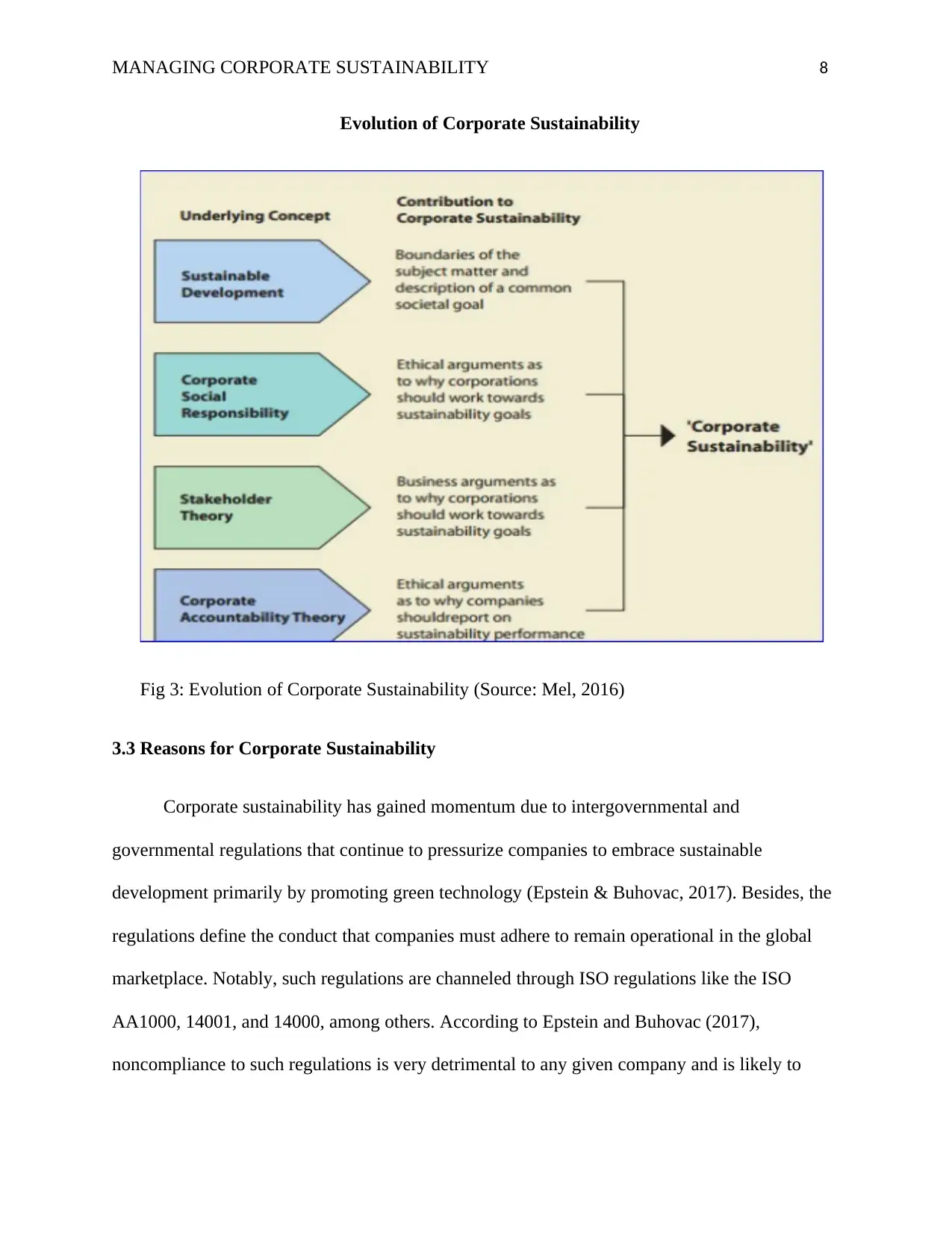
MANAGING CORPORATE SUSTAINABILITY 8
Evolution of Corporate Sustainability
Fig 3: Evolution of Corporate Sustainability (Source: Mel, 2016)
3.3 Reasons for Corporate Sustainability
Corporate sustainability has gained momentum due to intergovernmental and
governmental regulations that continue to pressurize companies to embrace sustainable
development primarily by promoting green technology (Epstein & Buhovac, 2017). Besides, the
regulations define the conduct that companies must adhere to remain operational in the global
marketplace. Notably, such regulations are channeled through ISO regulations like the ISO
AA1000, 14001, and 14000, among others. According to Epstein and Buhovac (2017),
noncompliance to such regulations is very detrimental to any given company and is likely to
Evolution of Corporate Sustainability
Fig 3: Evolution of Corporate Sustainability (Source: Mel, 2016)
3.3 Reasons for Corporate Sustainability
Corporate sustainability has gained momentum due to intergovernmental and
governmental regulations that continue to pressurize companies to embrace sustainable
development primarily by promoting green technology (Epstein & Buhovac, 2017). Besides, the
regulations define the conduct that companies must adhere to remain operational in the global
marketplace. Notably, such regulations are channeled through ISO regulations like the ISO
AA1000, 14001, and 14000, among others. According to Epstein and Buhovac (2017),
noncompliance to such regulations is very detrimental to any given company and is likely to
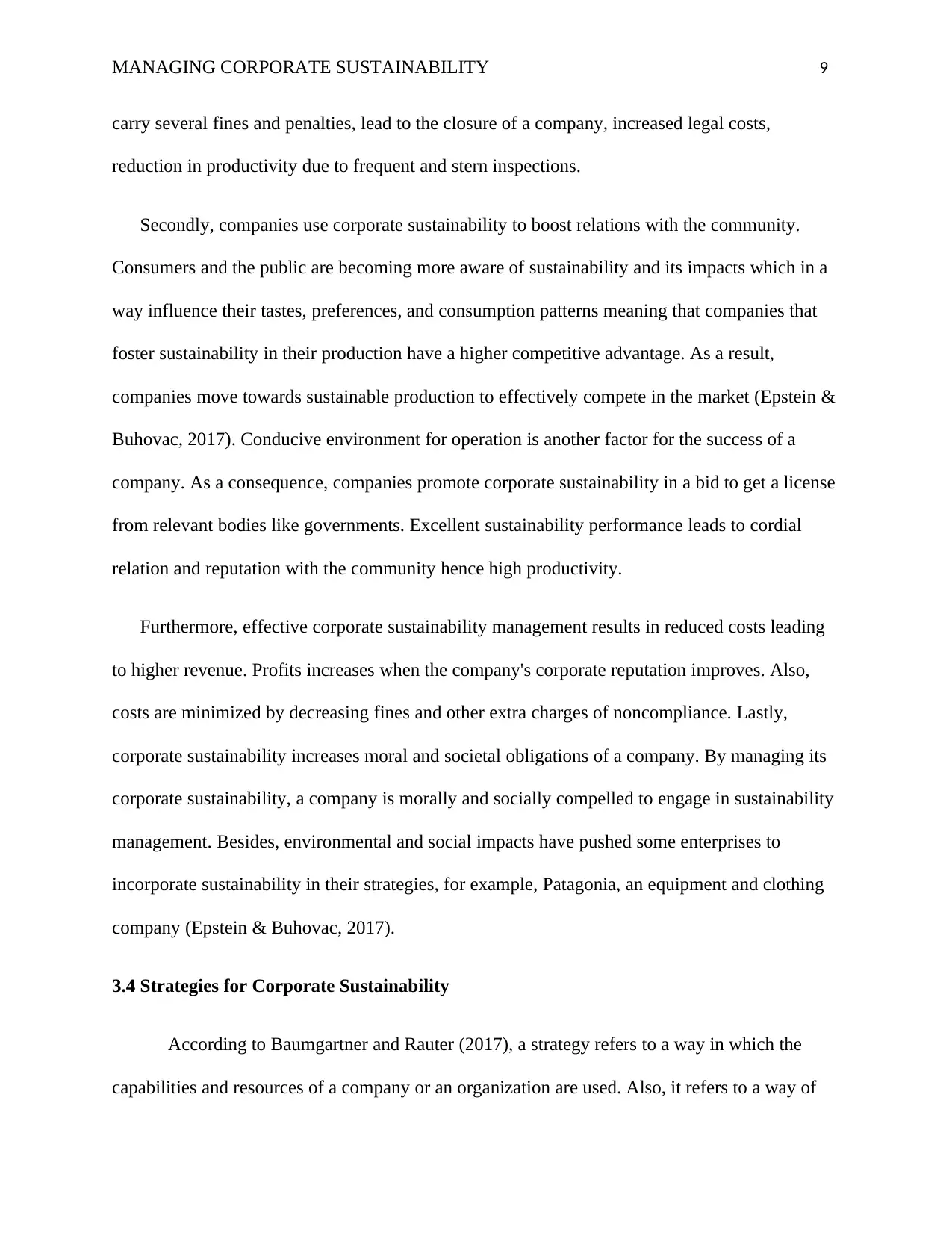
MANAGING CORPORATE SUSTAINABILITY 9
carry several fines and penalties, lead to the closure of a company, increased legal costs,
reduction in productivity due to frequent and stern inspections.
Secondly, companies use corporate sustainability to boost relations with the community.
Consumers and the public are becoming more aware of sustainability and its impacts which in a
way influence their tastes, preferences, and consumption patterns meaning that companies that
foster sustainability in their production have a higher competitive advantage. As a result,
companies move towards sustainable production to effectively compete in the market (Epstein &
Buhovac, 2017). Conducive environment for operation is another factor for the success of a
company. As a consequence, companies promote corporate sustainability in a bid to get a license
from relevant bodies like governments. Excellent sustainability performance leads to cordial
relation and reputation with the community hence high productivity.
Furthermore, effective corporate sustainability management results in reduced costs leading
to higher revenue. Profits increases when the company's corporate reputation improves. Also,
costs are minimized by decreasing fines and other extra charges of noncompliance. Lastly,
corporate sustainability increases moral and societal obligations of a company. By managing its
corporate sustainability, a company is morally and socially compelled to engage in sustainability
management. Besides, environmental and social impacts have pushed some enterprises to
incorporate sustainability in their strategies, for example, Patagonia, an equipment and clothing
company (Epstein & Buhovac, 2017).
3.4 Strategies for Corporate Sustainability
According to Baumgartner and Rauter (2017), a strategy refers to a way in which the
capabilities and resources of a company or an organization are used. Also, it refers to a way of
carry several fines and penalties, lead to the closure of a company, increased legal costs,
reduction in productivity due to frequent and stern inspections.
Secondly, companies use corporate sustainability to boost relations with the community.
Consumers and the public are becoming more aware of sustainability and its impacts which in a
way influence their tastes, preferences, and consumption patterns meaning that companies that
foster sustainability in their production have a higher competitive advantage. As a result,
companies move towards sustainable production to effectively compete in the market (Epstein &
Buhovac, 2017). Conducive environment for operation is another factor for the success of a
company. As a consequence, companies promote corporate sustainability in a bid to get a license
from relevant bodies like governments. Excellent sustainability performance leads to cordial
relation and reputation with the community hence high productivity.
Furthermore, effective corporate sustainability management results in reduced costs leading
to higher revenue. Profits increases when the company's corporate reputation improves. Also,
costs are minimized by decreasing fines and other extra charges of noncompliance. Lastly,
corporate sustainability increases moral and societal obligations of a company. By managing its
corporate sustainability, a company is morally and socially compelled to engage in sustainability
management. Besides, environmental and social impacts have pushed some enterprises to
incorporate sustainability in their strategies, for example, Patagonia, an equipment and clothing
company (Epstein & Buhovac, 2017).
3.4 Strategies for Corporate Sustainability
According to Baumgartner and Rauter (2017), a strategy refers to a way in which the
capabilities and resources of a company or an organization are used. Also, it refers to a way of
⊘ This is a preview!⊘
Do you want full access?
Subscribe today to unlock all pages.

Trusted by 1+ million students worldwide

MANAGING CORPORATE SUSTAINABILITY 10
making decisions on what business an enterprise should be involved in, how it wants the
business to be and the modes of operations. To manage sustainability, companies need a strategy
upon which their opportunities and threats can be identified and developed. Besides, the
strategies are helpful not only to them but also to the society at large. However, many companies
put in little effort towards sustainability so much so that sustainable development has been
impeded generating the need for concrete criteria which guide companies to work sustainably
and strategically. These strategies offer a framework on the relevance of sustainability and the
useful aspects.
Furthermore, the development of proactive sustainability strategies which are in line
with the vision and mission of the company is done by the strategic level of a company while
strategy implementation is done by different operation levels (Baumgartner & Rauter, 2017).
Baumgartner and Rauter (2017) add that an effective strategy for managing corporate
sustainability gets support from instruments spread in different levels of an organization.
Examples of strategies used by companies to achieve corporate sustainability include managing
knowledge through sustainable information and communication technology, forming
partnerships or strategic alliances, and a policy on social and environmental governance.
making decisions on what business an enterprise should be involved in, how it wants the
business to be and the modes of operations. To manage sustainability, companies need a strategy
upon which their opportunities and threats can be identified and developed. Besides, the
strategies are helpful not only to them but also to the society at large. However, many companies
put in little effort towards sustainability so much so that sustainable development has been
impeded generating the need for concrete criteria which guide companies to work sustainably
and strategically. These strategies offer a framework on the relevance of sustainability and the
useful aspects.
Furthermore, the development of proactive sustainability strategies which are in line
with the vision and mission of the company is done by the strategic level of a company while
strategy implementation is done by different operation levels (Baumgartner & Rauter, 2017).
Baumgartner and Rauter (2017) add that an effective strategy for managing corporate
sustainability gets support from instruments spread in different levels of an organization.
Examples of strategies used by companies to achieve corporate sustainability include managing
knowledge through sustainable information and communication technology, forming
partnerships or strategic alliances, and a policy on social and environmental governance.
Paraphrase This Document
Need a fresh take? Get an instant paraphrase of this document with our AI Paraphraser
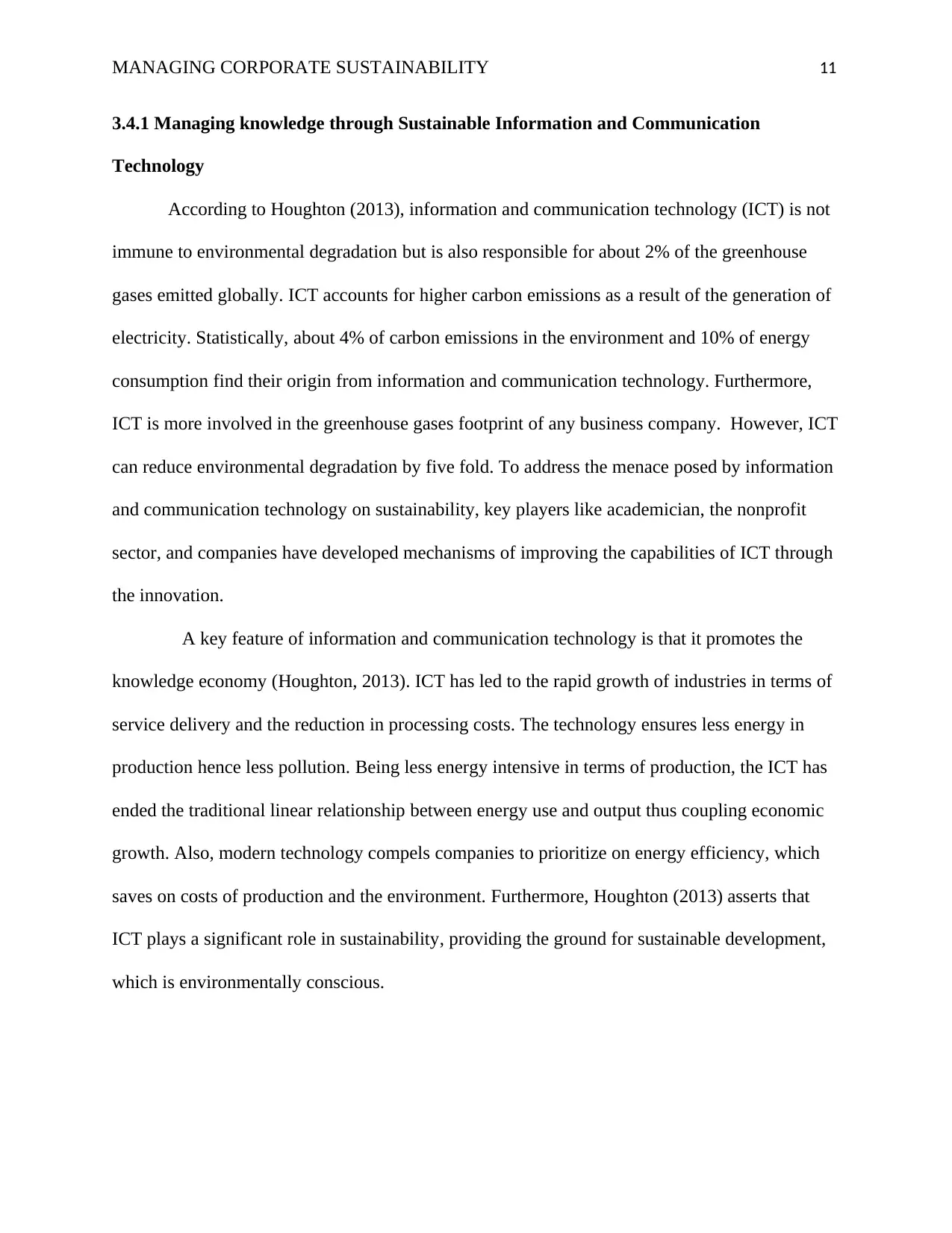
MANAGING CORPORATE SUSTAINABILITY 11
3.4.1 Managing knowledge through Sustainable Information and Communication
Technology
According to Houghton (2013), information and communication technology (ICT) is not
immune to environmental degradation but is also responsible for about 2% of the greenhouse
gases emitted globally. ICT accounts for higher carbon emissions as a result of the generation of
electricity. Statistically, about 4% of carbon emissions in the environment and 10% of energy
consumption find their origin from information and communication technology. Furthermore,
ICT is more involved in the greenhouse gases footprint of any business company. However, ICT
can reduce environmental degradation by five fold. To address the menace posed by information
and communication technology on sustainability, key players like academician, the nonprofit
sector, and companies have developed mechanisms of improving the capabilities of ICT through
the innovation.
A key feature of information and communication technology is that it promotes the
knowledge economy (Houghton, 2013). ICT has led to the rapid growth of industries in terms of
service delivery and the reduction in processing costs. The technology ensures less energy in
production hence less pollution. Being less energy intensive in terms of production, the ICT has
ended the traditional linear relationship between energy use and output thus coupling economic
growth. Also, modern technology compels companies to prioritize on energy efficiency, which
saves on costs of production and the environment. Furthermore, Houghton (2013) asserts that
ICT plays a significant role in sustainability, providing the ground for sustainable development,
which is environmentally conscious.
3.4.1 Managing knowledge through Sustainable Information and Communication
Technology
According to Houghton (2013), information and communication technology (ICT) is not
immune to environmental degradation but is also responsible for about 2% of the greenhouse
gases emitted globally. ICT accounts for higher carbon emissions as a result of the generation of
electricity. Statistically, about 4% of carbon emissions in the environment and 10% of energy
consumption find their origin from information and communication technology. Furthermore,
ICT is more involved in the greenhouse gases footprint of any business company. However, ICT
can reduce environmental degradation by five fold. To address the menace posed by information
and communication technology on sustainability, key players like academician, the nonprofit
sector, and companies have developed mechanisms of improving the capabilities of ICT through
the innovation.
A key feature of information and communication technology is that it promotes the
knowledge economy (Houghton, 2013). ICT has led to the rapid growth of industries in terms of
service delivery and the reduction in processing costs. The technology ensures less energy in
production hence less pollution. Being less energy intensive in terms of production, the ICT has
ended the traditional linear relationship between energy use and output thus coupling economic
growth. Also, modern technology compels companies to prioritize on energy efficiency, which
saves on costs of production and the environment. Furthermore, Houghton (2013) asserts that
ICT plays a significant role in sustainability, providing the ground for sustainable development,
which is environmentally conscious.
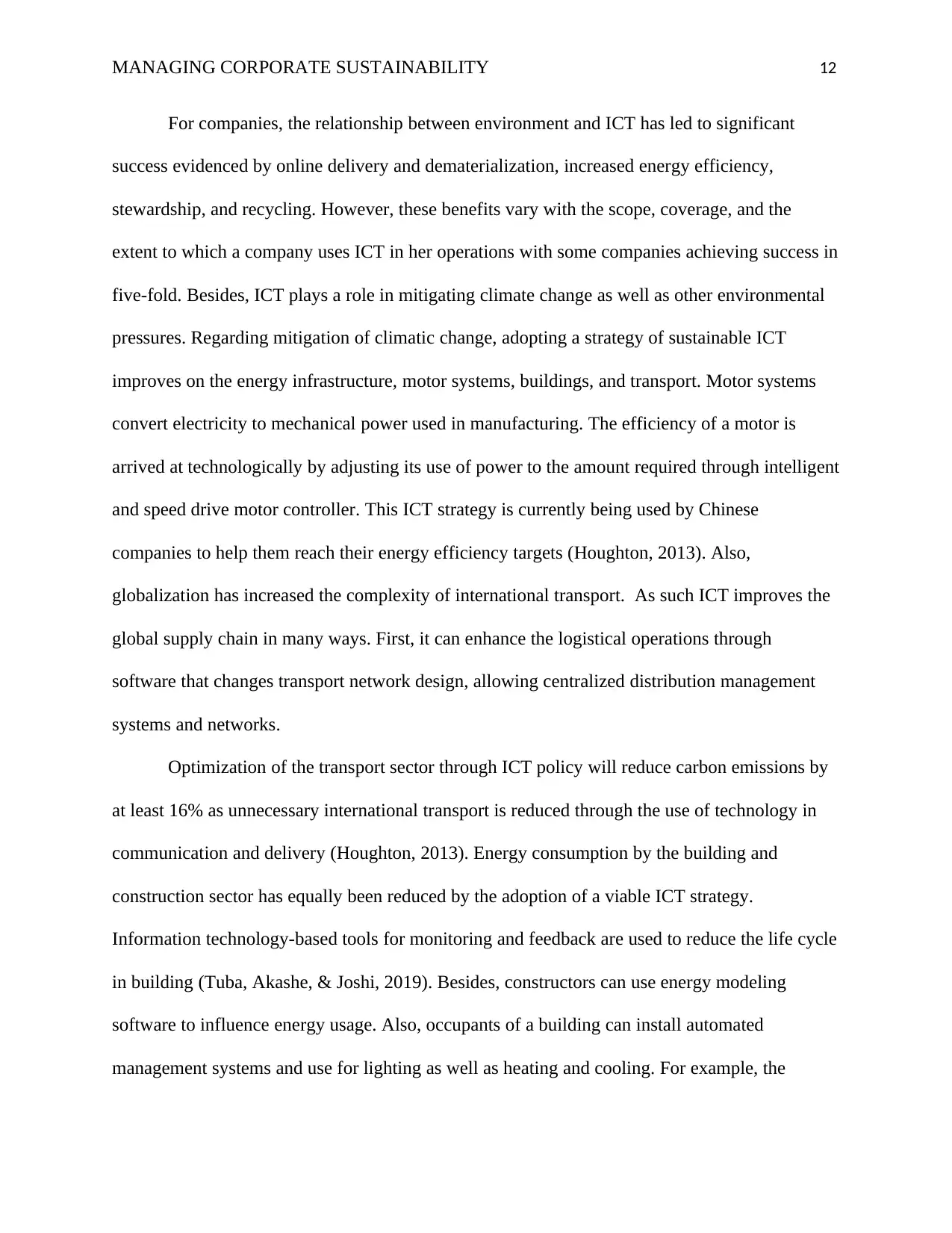
MANAGING CORPORATE SUSTAINABILITY 12
For companies, the relationship between environment and ICT has led to significant
success evidenced by online delivery and dematerialization, increased energy efficiency,
stewardship, and recycling. However, these benefits vary with the scope, coverage, and the
extent to which a company uses ICT in her operations with some companies achieving success in
five-fold. Besides, ICT plays a role in mitigating climate change as well as other environmental
pressures. Regarding mitigation of climatic change, adopting a strategy of sustainable ICT
improves on the energy infrastructure, motor systems, buildings, and transport. Motor systems
convert electricity to mechanical power used in manufacturing. The efficiency of a motor is
arrived at technologically by adjusting its use of power to the amount required through intelligent
and speed drive motor controller. This ICT strategy is currently being used by Chinese
companies to help them reach their energy efficiency targets (Houghton, 2013). Also,
globalization has increased the complexity of international transport. As such ICT improves the
global supply chain in many ways. First, it can enhance the logistical operations through
software that changes transport network design, allowing centralized distribution management
systems and networks.
Optimization of the transport sector through ICT policy will reduce carbon emissions by
at least 16% as unnecessary international transport is reduced through the use of technology in
communication and delivery (Houghton, 2013). Energy consumption by the building and
construction sector has equally been reduced by the adoption of a viable ICT strategy.
Information technology-based tools for monitoring and feedback are used to reduce the life cycle
in building (Tuba, Akashe, & Joshi, 2019). Besides, constructors can use energy modeling
software to influence energy usage. Also, occupants of a building can install automated
management systems and use for lighting as well as heating and cooling. For example, the
For companies, the relationship between environment and ICT has led to significant
success evidenced by online delivery and dematerialization, increased energy efficiency,
stewardship, and recycling. However, these benefits vary with the scope, coverage, and the
extent to which a company uses ICT in her operations with some companies achieving success in
five-fold. Besides, ICT plays a role in mitigating climate change as well as other environmental
pressures. Regarding mitigation of climatic change, adopting a strategy of sustainable ICT
improves on the energy infrastructure, motor systems, buildings, and transport. Motor systems
convert electricity to mechanical power used in manufacturing. The efficiency of a motor is
arrived at technologically by adjusting its use of power to the amount required through intelligent
and speed drive motor controller. This ICT strategy is currently being used by Chinese
companies to help them reach their energy efficiency targets (Houghton, 2013). Also,
globalization has increased the complexity of international transport. As such ICT improves the
global supply chain in many ways. First, it can enhance the logistical operations through
software that changes transport network design, allowing centralized distribution management
systems and networks.
Optimization of the transport sector through ICT policy will reduce carbon emissions by
at least 16% as unnecessary international transport is reduced through the use of technology in
communication and delivery (Houghton, 2013). Energy consumption by the building and
construction sector has equally been reduced by the adoption of a viable ICT strategy.
Information technology-based tools for monitoring and feedback are used to reduce the life cycle
in building (Tuba, Akashe, & Joshi, 2019). Besides, constructors can use energy modeling
software to influence energy usage. Also, occupants of a building can install automated
management systems and use for lighting as well as heating and cooling. For example, the
⊘ This is a preview!⊘
Do you want full access?
Subscribe today to unlock all pages.

Trusted by 1+ million students worldwide
1 out of 18
Related Documents
Your All-in-One AI-Powered Toolkit for Academic Success.
+13062052269
info@desklib.com
Available 24*7 on WhatsApp / Email
![[object Object]](/_next/static/media/star-bottom.7253800d.svg)
Unlock your academic potential
Copyright © 2020–2025 A2Z Services. All Rights Reserved. Developed and managed by ZUCOL.





